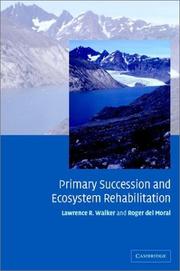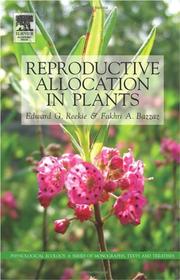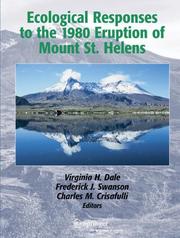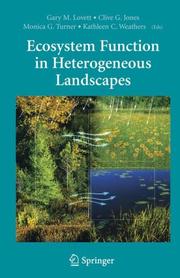| Listing 1 - 10 of 10 |
Sort by
|
Book
ISBN: 9781610911382 1610911385 9781597261845 159726184X 9781597261852 1597261858 Year: 2009 Publisher: Washington
Abstract | Keywords | Export | Availability | Bookmark
 Loading...
Loading...Choose an application
- Reference Manager
- EndNote
- RefWorks (Direct export to RefWorks)
Conceptual models based on alternative stable states and restoration thresholds can help inform restoration efforts. New Models for Ecosystem Dynamics and Restoration brings together leading experts from around the world to explore how conceptual models of ecosystem dynamics can be applied to the recovery of degraded systems and how recent advances in our understanding of ecosystem and landscape dynamics can be translated into conceptual and practical frameworks for restoration.
Restoration ecology. --- Ecological succession. --- Ecosystem management.

ISBN: 1107130271 1280430311 9786610430314 1139147005 0511178662 0511063288 0511056958 0511305885 0511615078 0511071744 9780511063282 9780521800761 0521800765 9780521529549 0521529549 9780511056956 9780511071744 9780511178665 9780511615078 9781280430312 6610430314 Year: 2003 Publisher: Cambridge, UK New York Cambridge University Press
Abstract | Keywords | Export | Availability | Bookmark
 Loading...
Loading...Choose an application
- Reference Manager
- EndNote
- RefWorks (Direct export to RefWorks)
Natural disturbances such as lava flows, landslides and glacial moraines, and human-damaged sites such as pavement, road edges and mine wastes often leave little or no soil or biological legacy. This 2003 book provided the first comprehensive summary of how plant, animal and microbial communities develop under the harsh conditions following such dramatic disturbances. The authors examine the basic principles that determine ecosystem development and apply the general rules to the urgent practical need for promoting the reclamation of damaged lands. Written for ecologists concerned with disturbance, landscape dynamics, restoration, life histories, invasions, modeling, soil formation and community or population dynamics, this book will also serve as an authoritative text for graduate students and a valuable reference for professionals involved in land management.
Ecological succession. --- Ecosystem management. --- Biotic communities --- Ecosystems management --- Applied ecology --- Environmental management --- Nature conservation --- Biodiversity conservation --- Biotic succession --- Succession, Ecological --- Management --- Natural disasters --- Environmental impact --- Bioremediation. --- Bioremediation --- ecological succession --- vegetation. --- vegetation
Book
ISBN: 1316307921 1316321304 1316324648 1316327981 1316331326 0521133335 1316317943 0511844212 1316287092 9781316317945 9780511844218 9781316327982 9781316287095 9780521116428 0521116422 Year: 2015 Publisher: New York
Abstract | Keywords | Export | Availability | Bookmark
 Loading...
Loading...Choose an application
- Reference Manager
- EndNote
- RefWorks (Direct export to RefWorks)
Much of what is considered conventional wisdom about succession is not as clear cut as it is generally believed. Yet, the importance of succession in ecology is undisputed since it offers a real insight into the dynamics and structure of all plant communities. Part monograph and part conceptual treatise, An Integrative Approach to Successional Dynamics presents a unifying conceptual framework for dynamic plant communities and uses a unique long-term data set to explore the utility of that framework. The fourteen chapters, each written in a nontechnical style and accompanied by numerous illustrations and examples, cover diverse aspects of succession, including: community, population and disturbance dynamics, diversity, community assembly, heterogeneity, functional ecology and biological invasion. This unique text will be a great source of reference for researchers and graduate students in ecology and plant biology and others with an interest in the subject.
Vegetation dynamics. --- Plant succession. --- Plant communities. --- Communities, Plant --- Phytosociology --- Plant associations --- Plant societies --- Biotic communities --- Plant ecology --- Succession, Plant --- Ecological succession --- Vegetation dynamics --- Dynamics of vegetation --- Acclimatization (Plants) --- Plant communities --- Vegetation and climate

ISBN: 0120883864 9786610633210 1280633212 008045433X 9780120883868 9780080454337 Year: 2005 Publisher: Amsterdam Boston Elsevier Academic Press
Abstract | Keywords | Export | Availability | Bookmark
 Loading...
Loading...Choose an application
- Reference Manager
- EndNote
- RefWorks (Direct export to RefWorks)
Much effort has been devoted to developing theories to explain the wide variation we observe in reproductive allocation among environments. Reproductive Allocation in Plants describes why plants differ in the proportion of their resources that they allocate to reproduction and looks into the various theories. This book examines the ecological and evolutionary explanations for variation in plant reproductive allocation from the perspective of the underlying physiological mechanisms controlling reproduction and growth. An international team of leading experts have prepared chapters summar
plants --- plant population --- population dynamics --- autecology --- reproduction. --- reproduction --- Plant reproductive organs --- propagation materials --- biological development --- life cycle --- site factors --- ecological succession --- Biological competition --- Plants --- Plant ecophysiology. --- Environmental plant physiology --- Physiological plant ecology --- Plant physiological ecology --- Ecophysiology --- Plant ecology --- Plant physiology --- Gemmation (Botany) --- Plant reproduction --- Reproduction --- Plants, Sex in --- Plant spores --- Reproduction.
Book
ISSN: 21924759 ISBN: 1283945320 9400758219 9400758200 Year: 2013 Publisher: New York : Springer,
Abstract | Keywords | Export | Availability | Bookmark
 Loading...
Loading...Choose an application
- Reference Manager
- EndNote
- RefWorks (Direct export to RefWorks)
The book reviews the literature on the ecological succession of plants on fallowed swiddens in tropical forests. Patterns of ecological succession in tropical forests are insufficiently understood, partly because results are scattered through a large number of case studies reported in academic articles. So far, no publication has attempted to bring these different case studies together to identify common patters and trends. The goal of the book is to review the different case studies, and identify common patterns of ecological succession in fallowed swiddens, as well as to pinpoint the factors that cause ecological succession in some areas to differ from those in other areas. The book is organised in four different sections: forest structure, forest diversity, species composition, and the factors that contribute to differences in forest recovery rates (the number of times the field was burned, the length of fallow period, the type of soil, and the type of forest). This book is an important contribution to tropical forestry and shifting cultivation. Deforestation and forest degradation are the largest sources of CO2, and shifting cultivation is one of the main culprits. For this (and other economic and political) reason governments attempt to curtail shifting cultivation by shortening the years the fields can be left fallow, or outright outlawing the farming practice. Yet, there is insufficient understanding of the processes of ecological succession in fallows, which raises the questions as to whether the policy fulfils its objectives. .
Ecological succession. --- Forest plants. --- Rain forest ecology. --- Equatorial forest ecology --- Rain forest ecology --- Rain forests --- Tropical rain forest ecology --- Forest botany --- Forest flora --- Forest vegetation --- Forest wildlife plants --- Forest-zone plants --- Wildlife plants, Forest --- Woodland plants --- Woodland vegetation --- Biotic succession --- Succession, Ecological --- Ecology --- Ecological succession -- Australia -- Queensland. --- Restoration ecology -- Australia -- Queensland. --- Forest succession --- Fallow lands --- Life sciences. --- Biodiversity. --- Plant ecology. --- Forestry. --- Plant science. --- Botany. --- Life Sciences. --- Plant Ecology. --- Plant Sciences. --- Forest ecology --- Forests and forestry --- Plants --- Woodland garden plants --- Forests and forestry. --- Botanical science --- Phytobiology --- Phytography --- Phytology --- Plant biology --- Plant science --- Biology --- Natural history --- Forest land --- Forest lands --- Forest planting --- Forest production --- Forest sciences --- Forestation --- Forested lands --- Forestland --- Forestlands --- Forestry --- Forestry industry --- Forestry sciences --- Land, Forest --- Lands, Forest --- Silviculture --- Sylviculture --- Woodlands --- Woods (Forests) --- Agriculture --- Natural resources --- Afforestation --- Arboriculture --- Logging --- Timber --- Tree crops --- Trees --- Biological diversification --- Biological diversity --- Biotic diversity --- Diversification, Biological --- Diversity, Biological --- Biocomplexity --- Ecological heterogeneity --- Numbers of species --- Botany --- Phytoecology --- Vegetation ecology --- Floristic botany --- Floristic ecology

ISBN: 0387238689 9786610459223 1280459220 0387281509 Year: 2005 Publisher: New York, NY : Springer,
Abstract | Keywords | Export | Availability | Bookmark
 Loading...
Loading...Choose an application
- Reference Manager
- EndNote
- RefWorks (Direct export to RefWorks)
The eruption of Mount St. Helens on May 18, 1980, had a momentous impact on the fungal, plant, animal, and human life from the mountain to the far reaches of the explosion's ash cloud and mudflows. Although this intense natural event caused loss of substantial life and property, it also created a unique opportunity to examine a huge disturbance of natural systems and their subsequent responses. Based on one of the most studied areas of volcanic activity, this book synthesizes the ecological research that has been conducted for twenty-five years since the eruption. Research from geology as well as plant and animal ecology has been integrated in this unprecedented look at the complex interactions of biological and physical systems in the response of the volcanic landscape. Lessons from the volcano inform our larger understanding of ecosystem disturbances, natural processes, and the impact of land-use practices. Included are results of significant and long-term research on vegetation, mycorrhizae, plant and animal interactions, arthropods, amphibians, mammals, fish, lakes, nutrient cycling, geomorphology, and environmental management. This comprehensive account will be of value to those interested in natural history, ecology, disturbance, conservation biology, limnology, geoscience, and land management. Questions about what actually happens when a volcano erupts, what the immediate and long-term dangers are, and how life reasserts itself in the environment are discussed in full detail. Virginia Dale is a Corporate Fellow in the Environmental Sciences Division at Oak Ridge National Laboratory. She is also an adjunct faculty member in the Department of Ecology and Evolutionary Biology at the University of Tennessee. Fred Swanson is a Research Geologist at the USDA Forest Service Pacific NW Research Station in Corvallis, OR. Charles Crisafulli is an Ecologist at the USDA Forest Service Pacific Northwest Research Station in Olympia, WA.
Life sciences. --- Geophysics. --- Geobiology. --- Ecology. --- Geoecology. --- Environmental geology. --- Life Sciences. --- Biogeosciences. --- Geophysics/Geodesy. --- Plant Systematics/Taxonomy/Biogeography. --- Geoecology/Natural Processes. --- Geoecology --- Environmental protection --- Physical geology --- Balance of nature --- Biology --- Bionomics --- Ecological processes --- Ecological science --- Ecological sciences --- Environment --- Environmental biology --- Oecology --- Environmental sciences --- Population biology --- Earth sciences --- Biosphere --- Geological physics --- Terrestrial physics --- Physics --- Biosciences --- Sciences, Life --- Science --- Ecology --- Ecological succession --- Saint Helens, Mount (Wash.) --- Eruption, 1980 --- Environmental aspects.
Book
ISBN: 1281087440 9786611087449 0387336427 0387336419 1441922172 Year: 2008 Publisher: New York : Springer,
Abstract | Keywords | Export | Availability | Bookmark
 Loading...
Loading...Choose an application
- Reference Manager
- EndNote
- RefWorks (Direct export to RefWorks)
Post-agricultural studies have been central to the development of both the science of plant ecology and ecology in general. The study of old field succession allows us to observe the development of the structure and function of communities, as well as understand the role of history and initial conditions in that process. Understanding old field succession can help the public address important scientific and social issues, such as deforestation and forest regeneration, forest restoration, sustainability of agriculture, maintenance of biodiversity, and impacts of global climate change on forest dynamics. Post-Agricultural Succession in the Neotropics draws implications from scientific studies for the wise management of old field ecosystems in the neotropics, where conversion of land to cropping systems is the most common kind of disturbance and many landscapes are defined by areas recovering from agriculture. Written for scientists, researchers, professionals, and students of ecology, the book provides a background in old field ecosystems and proposes restoration strategies and a trajectory for future research. Farmers and decision makers can also benefit from new farming methodologies and management strategies that are proposed. About the Author: Dr. Randall W. Myster is a Researcher at the Institute for Tropical Ecosystem Studies at the University of Puerto Rico.
Forest regeneration --- Ecological succession --- Biotic succession --- Succession, Ecological --- Forest reproduction --- Natural tree regeneration --- Regeneration (Forestry) --- Tree regeneration --- Trees --- Reproduction --- Environmental management. --- Plant Ecology. --- Landscape ecology. --- Applied Ecology. --- Nature Conservation. --- Soil conservation. --- Environmental Management. --- Landscape Ecology. --- Soil Science & Conservation. --- Conservation of soil --- Erosion control, Soil --- Soil erosion --- Soil erosion control --- Soils --- Agricultural conservation --- Soil management --- Conservation of nature --- Nature --- Nature protection --- Protection of nature --- Conservation of natural resources --- Applied ecology --- Conservation biology --- Endangered ecosystems --- Natural areas --- Ecology --- Environmental protection --- Nature conservation --- Botany --- Plants --- Environmental stewardship --- Stewardship, Environmental --- Environmental sciences --- Management --- Control --- Prevention --- Conservation --- Phytoecology --- Vegetation ecology --- Plant ecology. --- Applied ecology. --- Nature conservation. --- Soil science. --- Pedology (Soil science) --- Agriculture --- Earth sciences --- Floristic ecology

ISBN: 1281250597 9786611250591 0387240918 0387240896 038724090X Year: 2006 Publisher: New York, NY : Springer,
Abstract | Keywords | Export | Availability | Bookmark
 Loading...
Loading...Choose an application
- Reference Manager
- EndNote
- RefWorks (Direct export to RefWorks)
The study of ecosystems, fundamental to ecology, has been complemented by the growing field of landscape ecology. Ecosystem Function in Heterogeneous Landscapes addresses how interactions among ecosystems affect the functioning of individual ecosystems and the larger landscape. This groundbreaking synthesis unites ecosystem ecology's knowledge of system function with landscape ecology's knowledge of spatial structure. Practical concerns about scaling up from individual ecosystems to larger landscapes require an understanding of how networks of interacting ecosystems function together. The book elucidates the challenges faced by ecosystem scientists working in spatially heterogeneous systems, relevant conceptual approaches used in other disciplines and in different ecosystem types, and the importance of spatial heterogeneity in conservation resource management. The distinguished authors discuss how how much heterogeneity needs to be taken into account for specific types of scientific and management issues. Their chapters cover the spectrum from proposing novel conceptual approaches to detailing the practical implications of heterogeneous landscapes for fire management, water management and conservation planning.
Biotic communities --- Landscape ecology --- ecosystems --- Landscape --- Aquatic environment --- biotopes --- population dynamics --- population structure --- land use --- Environmental impact --- ecological succession --- environmental factors --- Biodiversity --- Natural resources --- resource management --- Ecology. --- Applied Ecology. --- Biodiversity. --- Endangered ecosystems. --- Landscape ecology. --- Ecosystems. --- Landscape Ecology. --- Terrestial Ecology. --- Ecology --- Threatened ecosystems --- Nature conservation --- Biological diversification --- Biological diversity --- Biotic diversity --- Diversification, Biological --- Diversity, Biological --- Biology --- Biocomplexity --- Ecological heterogeneity --- Numbers of species --- Environmental protection --- Balance of nature --- Bionomics --- Ecological processes --- Ecological science --- Ecological sciences --- Environment --- Environmental biology --- Oecology --- Environmental sciences --- Population biology --- Ecology . --- Applied ecology. --- Biocenoses --- Biocoenoses --- Biogeoecology --- Biological communities --- Biomes --- Biotic community ecology --- Communities, Biotic --- Community ecology, Biotic --- Ecological communities --- Ecosystems --- Natural communities
Book

ISSN: 09984658 ISBN: 2709914425 2742003029 2709924781 9782709924788 Year: 2018 Publisher: Marseille : IRD Éditions,
Abstract | Keywords | Export | Availability | Bookmark
 Loading...
Loading...Choose an application
- Reference Manager
- EndNote
- RefWorks (Direct export to RefWorks)
Introduire et faire adopter des nouveautés est une préoccupation permanente des organismes de recherche et de développement agricole dans les pays du Sud. Pour exprimer cet objectif, le terme d’innovation s’est tardivement substitué à celui de vulgarisation et, dès lors, son usage s’est généralisé dans la recherche ruraliste francophone. Simple question de vocabulaire, ou conception vraiment nouvelle du développement ? Cet ouvrage restitue les réflexions d’un groupe de chercheurs en agronomie et en sciences humaines qui confrontent leurs analyses des dynamiques agraires au paradigme de l’innovation. Les auteurs posent ce concept comme une « entrée » pour mieux comprendre les transformations des agricultures et des sociétés rurales. Le recours à la notion d’innovation permet de préciser des hypothèses dans le domaine des dynamiques agraires. Inversement, ce champ de recherches participe à une clarification du concept d’innovation. Dès lors, des échanges deviennent possibles entre spécialistes de l’innovation et spécialistes des études agraires dans les pays en voie de développement, par exemple autour du constat du caractère “ procédural ” de la mise en oeuvre des innovations par les différents acteurs concernés. Les auteurs soulignent l’importance d’une démarche historique et qualitative dans l’analyse des dynamiques agraires, de façon à dépasser une interprétation linéaire et déterministe du changement. Les réflexions théoriques s’appuient sur des études de cas qui concernent des domaines ruraux divers et qui relèvent de contextes géographiques variés. The introduction and adoption of new ideas is a permanent concern for the research and agricultural development institutes in Southern countries. For this, the term 'innovation' has recently replaced 'extension' and its use has become widespread in francophone rural research. Is this a mere question of vocabulary or a truly new development concept? The reflections of a group of researchers in agronomy,…
fallow --- Soil biology --- ecological succession --- Grazing --- pasture improvement --- reclamation --- agrosilvopastoral systems --- Hedges --- Africa South of Sahara --- West Africa --- Agricultural innovations --- Social aspects --- Tropical zones --- bush fallowing --- Crop rotation --- Burning --- Controlled burning --- Production increase --- Sustainable development --- Soil conservation --- soil fertility --- organic matter --- Water resources --- Soil resources --- resource management --- forage --- Forestry production --- Africa --- Agriculture --- Innovations, Agricultural --- Technological change in agriculture --- Technological innovations --- Innovations --- Technology transfer --- innovation --- système agraire --- pêche artisanale --- industrie agroalimentaire --- consommation alimentaire --- rapports sociaux --- développement rural --- pays du Sud --- concept --- agroforesterie --- démographie --- étude de cas --- impact sur l’environnement --- exploitation des ressources naturelles --- agronomie --- tiers monde --- Africa south of the sahara
Book
ISBN: 1281116815 9786611116811 0387353038 Year: 2007 Publisher: New York, NY : Springer,
Abstract | Keywords | Export | Availability | Bookmark
 Loading...
Loading...Choose an application
- Reference Manager
- EndNote
- RefWorks (Direct export to RefWorks)
While studies of restoration and ecological succession have been published independently, there is much overlap between these approaches that has not been adequately explored. Linking Restoration and Ecological Succession integrates practical information from restoration projects around the world with the latest developments in successional theory. This innovative book recognizes the critical roles of disturbance ecology, landscape ecology, ecological assembly, invasion biology, ecosystem health, and historical ecology in habitat restoration and argues that restoration within a successional context will best utilize the lessons from each of these disciplines. To successfully restore an ecosystem that needs minimal care, the temporal dynamics of successional processes must be considered. By re-examining restoration in the light of succession, the authors hope to encourage the development of new approaches to the practice of restoration supported by solid ecological principles. About the Editors: Dr. Lawrence R. Walker is Professor in the Department of Biological Sciences at the University of Nevada, Las Vegas, USA. Dr. Joe Walker is Honorary Research Fellow at CSIRO Land and Water, Canberra, Australia. Dr. Richard J. Hobbs is Professor of Environmental Science at the School of Environmental Science, Murdoch University, Murdoch, Australia.
Ecological succession --- Restoration ecology --- Ecological restoration --- Ecosystem restoration --- Rehabilitation ecology --- Restoration of ecosystems --- Applied ecology --- Biotic succession --- Succession, Ecological --- Endangered ecosystems. --- Nature Conservation. --- Landscape ecology. --- Plant Ecology. --- Forests and forestry. --- Ecology. --- Ecosystems. --- Landscape Ecology. --- Forestry. --- Community & Population Ecology. --- Balance of nature --- Biology --- Bionomics --- Ecological processes --- Ecological science --- Ecological sciences --- Environment --- Environmental biology --- Oecology --- Environmental sciences --- Population biology --- Conservation of nature --- Nature --- Nature protection --- Protection of nature --- Conservation of natural resources --- Conservation biology --- Endangered ecosystems --- Natural areas --- Forest land --- Forest lands --- Forest planting --- Forest production --- Forest sciences --- Forestation --- Forested lands --- Forestland --- Forestlands --- Forestry --- Forestry industry --- Forestry sciences --- Land, Forest --- Lands, Forest --- Silviculture --- Sylviculture --- Woodlands --- Woods (Forests) --- Agriculture --- Natural resources --- Afforestation --- Arboriculture --- Logging --- Timber --- Tree crops --- Trees --- Botany --- Plants --- Ecology --- Threatened ecosystems --- Biotic communities --- Nature conservation --- Conservation --- Phytoecology --- Vegetation ecology --- Nature conservation. --- Plant ecology. --- Community ecology, Biotic. --- Biocenoses --- Biocoenoses --- Biogeoecology --- Biological communities --- Biomes --- Biotic community ecology --- Communities, Biotic --- Community ecology, Biotic --- Ecological communities --- Ecosystems --- Natural communities --- Floristic ecology
| Listing 1 - 10 of 10 |
Sort by
|

 Search
Search Feedback
Feedback About UniCat
About UniCat  Help
Help News
News